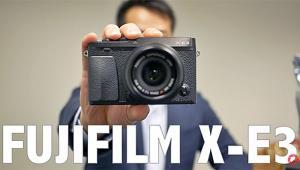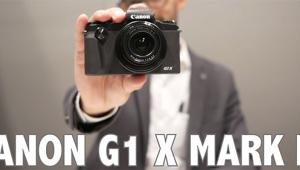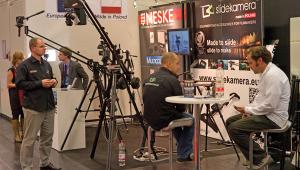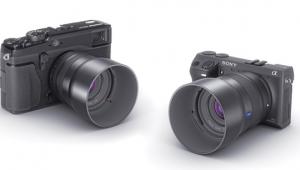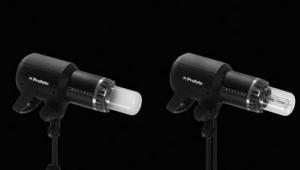Something For Everyone
 Considering
the overwhelming popularity of digital SLR cameras, it's understandable
that all lens manufacturers are devoting their resources to this market. All
of the new products--featuring entirely new designs--shown during
PMA 2005 were exclusively for use with digital SLRs that employ the APS-C size
sensor; these are not suitable for use with film-based cameras. (Vignetting
will occur if such a lens were used on a 35mm camera or a digital SLR with a
larger sensor.)
Considering
the overwhelming popularity of digital SLR cameras, it's understandable
that all lens manufacturers are devoting their resources to this market. All
of the new products--featuring entirely new designs--shown during
PMA 2005 were exclusively for use with digital SLRs that employ the APS-C size
sensor; these are not suitable for use with film-based cameras. (Vignetting
will occur if such a lens were used on a 35mm camera or a digital SLR with a
larger sensor.)
Owners of other types of cameras could not complain about being ignored, because
Sigma unveiled 10 multi-platform lenses upgraded to the DG (Digitally Optimized)
standard. They're not "entirely new" however, because they
incorporate the same optical designs as the previous incarnations of the same
products. The significant difference is the addition of superior multilayered
coatings to more elements, as discussed later.
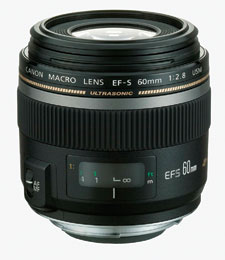 |
 |
||
|
|
Multi-Platform Lenses
The new "Digitally Optimized" Sigma lenses are all telephotos, either
prime or zoom. They include the following
multi-platform models: APO 50-500mm f/4-6.3 EX, APO 70-200mm f/2.8 EX, APO 80-400mm
f/4.5-5.6 EX OS (with Optical Stabilizer), APO 100-300mm f/4 EX, APO 120-300mm
f/2.8 EX, APO 300-800mm f/5.6 EX, APO 180mm f/3.5 EX, APO 300mm f/2.8 EX, APO
500mm f/4.5 EX, and APO 800mm f/5.6 EX. All of these products benefit from the
latest
anti-reflective technology in order to compensate for the increased risk of
flare with digital cameras' highly reflective (almost mirror-like) sensor
chips. Naturally, the DG series should provide higher contrast and greater resistance
to flare and ghosting in extremely bright conditions, regardless of the type
of camera used. (Prices not yet set.)
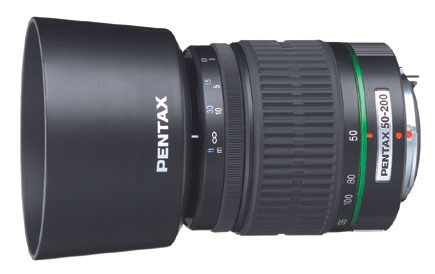 |
|
|
Wide Angle And "Normal" Lenses
All of the other new entries were designed exclusively for use for digital cameras
with the APS-C size sensors. The lenses are smaller because they must cover
an image circle that's smaller than a 35mm film frame. Hence, they're
also lighter in weight than the comparable multi-platform lenses that provide
equivalent focal lengths in film-based photography. Some, but not all, are also
less expensive than the comparable multi-platform lenses; they're not
cheap because of the extra high-tech optical elements required for the full
correction required in digital photography.
Particularly short focal length lenses benefit from new optical designs and
technology, as mentioned in my coverage of each new lens. For a detailed discussion
of the entire issue relating to lenses for digital SLRs, review our article
on Digitally Optimized Lenses in the March 2005 issue; it's also available
on the shutterbug.com website, easily found using the Search feature.
 |
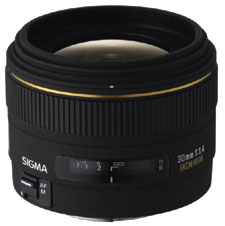 |
||
|
|
The shortest zoom in the Tamron line, the new SP AF11-18mm f/4.5-5.6 Di-II
LD Aspherical (IF) zoom (exclusively for digital SLRs) is roughly equivalent
to a 17-28mm zoom in 35mm terms. (For exact focal length equivalents for any
lens, multiply by the appropriate magnification factor, such as 1.5x or 1.6x.)
This zoom was designed to ensure that all light rays strike the image sensor
at an optimum angle for even edge to edge brightness.
Special multilayered coatings on numerous elements minimize internal flare and
ghosting that can be caused by a highly reflective CCD or CMOS sensor. The optical
formula is impressive, too, including a glass-molded aspherical element, hybrid
aspherical elements, plus elements of high index/high dispersion as well as
low dispersion glass, intended to produce the best possible results. This zoom
is quite compact for an ultra-wide with a length of 3.3" and 77mm size
filters. It's available in Canon AF, Konica Minolta AF-D, and Nikon AF-D
mounts. (Estimated street price: $549.)
Sigma's shortest zoom, the new 10-20mm f/4-5.6 EX DC HSM, is part of the
DC ("Digital Capture") series so it benefits from superior multilayered
coatings as well as other technology to ensure even brightness and sharpness
across the frame. Designed to provide an ultra-wide angle of view with Sigma,
Canon, or Nikon digital SLRs, the optical formula includes three Special Low
Dispersion (SLD) elements plus three aspherical lens elements for outstanding
image quality. Other features include a non-rotating lens barrel for great convenience
when using a (77mm) polarizer and ultrasonic HSM focus motor. The latter provides
high speed, nearly silent autofocus performance as well as manual focus override
without the need to switch out of autofocus mode. (Estimated street price: $649.)
 |
 |
||
|
|
THK Photo Products, Inc. has also entered the market with the first Tokina
DX-series zoom designed exclusively for digital SLRs. The AF 12-24mm f/4 AT-X
Pro DX zoom features a wide, constant maximum aperture great for low-light focusing
and shooting. Surprisingly, this fast zoom is not much larger than the variable
aperture ultra wides (3.3" long, 77mm filter size), although its 3.5"
diameter is greater than the 3.1" average and it's a bit heavier.
- Log in or register to post comments
